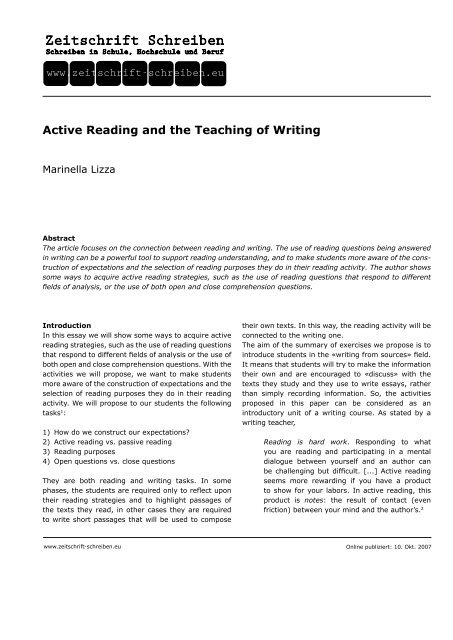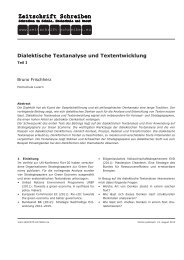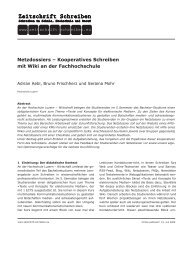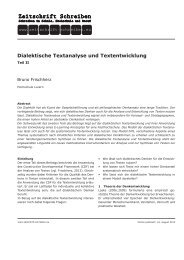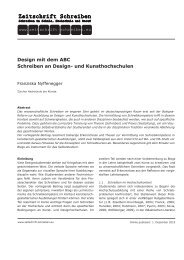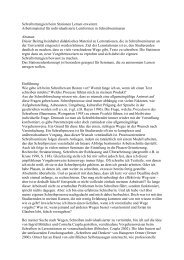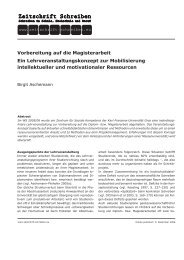Active Reading and the Teaching of Writing - Zeitschrift Schreiben
Active Reading and the Teaching of Writing - Zeitschrift Schreiben
Active Reading and the Teaching of Writing - Zeitschrift Schreiben
Create successful ePaper yourself
Turn your PDF publications into a flip-book with our unique Google optimized e-Paper software.
<strong>Active</strong> <strong>Reading</strong> <strong>and</strong> <strong>the</strong> <strong>Teaching</strong> <strong>of</strong> <strong>Writing</strong><br />
Marinella Lizza<br />
Abstract<br />
The article focuses on <strong>the</strong> connection between reading <strong>and</strong> writing. The use <strong>of</strong> reading questions being answered<br />
in writing can be a powerful tool to support reading underst<strong>and</strong>ing, <strong>and</strong> to make students more aware <strong>of</strong> <strong>the</strong> construction<br />
<strong>of</strong> expectations <strong>and</strong> <strong>the</strong> selection <strong>of</strong> reading purposes <strong>the</strong>y do in <strong>the</strong>ir reading activity. The author shows<br />
some ways to acquire active reading strategies, such as <strong>the</strong> use <strong>of</strong> reading questions that respond to different<br />
fields <strong>of</strong> analysis, or <strong>the</strong> use <strong>of</strong> both open <strong>and</strong> close comprehension questions.<br />
Introduction<br />
In this essay we will show some ways to acquire active<br />
reading strategies, such as <strong>the</strong> use <strong>of</strong> reading questions<br />
that respond to different fields <strong>of</strong> analysis or <strong>the</strong> use <strong>of</strong><br />
both open <strong>and</strong> close comprehension questions. With <strong>the</strong><br />
activities we will propose, we want to make students<br />
more aware <strong>of</strong> <strong>the</strong> construction <strong>of</strong> expectations <strong>and</strong> <strong>the</strong><br />
selection <strong>of</strong> reading purposes <strong>the</strong>y do in <strong>the</strong>ir reading<br />
activity. We will propose to our students <strong>the</strong> following<br />
tasks 1 :<br />
1) How do we construct our expectations?<br />
2) <strong>Active</strong> reading vs. passive reading<br />
3) <strong>Reading</strong> purposes<br />
4) Open questions vs. close questions<br />
They are both reading <strong>and</strong> writing tasks. In some<br />
phases, <strong>the</strong> students are required only to reflect upon<br />
<strong>the</strong>ir reading strategies <strong>and</strong> to highlight passages <strong>of</strong><br />
<strong>the</strong> texts <strong>the</strong>y read, in o<strong>the</strong>r cases <strong>the</strong>y are required<br />
to write short passages that will be used to compose<br />
<strong>the</strong>ir own texts. In this way, <strong>the</strong> reading activity will be<br />
connected to <strong>the</strong> writing one.<br />
The aim <strong>of</strong> <strong>the</strong> summary <strong>of</strong> exercises we propose is to<br />
introduce students in <strong>the</strong> «writing from sources» field.<br />
It means that students will try to make <strong>the</strong> information<br />
<strong>the</strong>ir own <strong>and</strong> are encouraged to «discuss» with <strong>the</strong><br />
texts <strong>the</strong>y study <strong>and</strong> <strong>the</strong>y use to write essays, ra<strong>the</strong>r<br />
than simply recording information. So, <strong>the</strong> activities<br />
proposed in this paper can be considered as an<br />
introductory unit <strong>of</strong> a writing course. As stated by a<br />
writing teacher,<br />
<strong>Reading</strong> is hard work. Responding to what<br />
you are reading <strong>and</strong> participating in a mental<br />
dialogue between yourself <strong>and</strong> an author can<br />
be challenging but difficult. [...] <strong>Active</strong> reading<br />
seems more rewarding if you have a product<br />
to show for your labors. In active reading, this<br />
product is notes: <strong>the</strong> result <strong>of</strong> contact (even<br />
friction) between your mind <strong>and</strong> <strong>the</strong> author’s. 2<br />
www.zeitschrift-schreiben.eu Online publiziert: 10. Okt. 2007
Which relationship is <strong>the</strong>re between writing <strong>and</strong><br />
reading?<br />
The relationship between writing <strong>and</strong> reading seems<br />
to be a very strong one: Mariolina Salvatori, who<br />
mentioned Andrea Lunsford’s studies too, stated that<br />
«<strong>the</strong> teacher <strong>of</strong> writing must automatically <strong>and</strong> always<br />
be a teacher <strong>of</strong> reading as well». 3 Salvatori mentioned<br />
also Ann Berth<strong>of</strong>f’s ideas: Berth<strong>of</strong>f suggested that when<br />
students learn to notice <strong>and</strong> confront uncertainties in<br />
<strong>the</strong> reading process, <strong>the</strong>y learn to deal with this kind<br />
<strong>of</strong> problems also in <strong>the</strong> process <strong>of</strong> writing <strong>the</strong>ir own<br />
texts. 4<br />
In this paper we are going to focus on active reading<br />
<strong>and</strong> to propose some exercises for high school <strong>and</strong><br />
college students, in particular for humanities students.<br />
Humanities students usually deal with two kinds <strong>of</strong><br />
texts: literary works <strong>and</strong> critical essays. These two<br />
categories are not in contraposition: students are<br />
always encouraged to apply, in <strong>the</strong> analysis <strong>of</strong> literary<br />
works, <strong>the</strong> <strong>the</strong>ories <strong>and</strong> <strong>the</strong> techniques <strong>the</strong>y learnt<br />
reading critical essays.<br />
Louise Rosenblatt, who first advanced <strong>the</strong> Reader-<br />
Response Theory in 1938, recognized <strong>the</strong> reader as<br />
an active agent, who adopts different approaches to<br />
different texts: when he reads a literary work, he is<br />
open to unexpected events; for example, every reader<br />
welcomes dramatic turns <strong>of</strong> events in <strong>the</strong> plot <strong>of</strong> a<br />
story (especially when he’s reading a spy story!). On<br />
<strong>the</strong> contrary, when he reads a critical essay (<strong>and</strong> when<br />
he already knows <strong>the</strong> main subject <strong>of</strong> <strong>the</strong> essay), he<br />
formulates some hypo<strong>the</strong>sis <strong>and</strong> tries to find in <strong>the</strong><br />
essay pro<strong>of</strong>s to confirm his hypo<strong>the</strong>sis. 5<br />
The teacher <strong>of</strong> writing can explain <strong>the</strong>se different<br />
approaches to his students, in order to make <strong>the</strong>m<br />
conscious <strong>of</strong> mind attitude in reading new texts. Then,<br />
<strong>the</strong> kind <strong>of</strong> text (literary or critical) can orient <strong>the</strong> kind<br />
<strong>of</strong> notes to take: for example, if <strong>the</strong> student reads <strong>and</strong><br />
summarizes a critical essay, his summary should sum<br />
up <strong>the</strong> <strong>the</strong>sis <strong>of</strong> <strong>the</strong> essay <strong>and</strong> its implications. We can<br />
test it with <strong>the</strong> following exercise.<br />
Exercise 1: How do we construct our expectations?<br />
In <strong>the</strong> first activity we propose, every student gets a<br />
brief text. The text is not complete, because <strong>the</strong> teacher<br />
cut <strong>of</strong>f <strong>the</strong> conclusive part. Students are required to<br />
read <strong>the</strong> text <strong>and</strong> to answer <strong>the</strong> following questions:<br />
1) What will be, in your idea, <strong>the</strong> conclusion <strong>of</strong> <strong>the</strong><br />
text?<br />
2) Which elements <strong>of</strong> <strong>the</strong> text support your idea? Please<br />
underline <strong>the</strong> key points <strong>of</strong> <strong>the</strong> text you read.<br />
The teacher reads <strong>the</strong> answers <strong>of</strong> <strong>the</strong> students, presents<br />
<strong>and</strong> discusses <strong>the</strong>m in <strong>the</strong> classroom <strong>and</strong> <strong>the</strong>n gives<br />
<strong>the</strong> students <strong>the</strong> conclusion <strong>of</strong> <strong>the</strong> text.<br />
To complete this exercise, students are supposed to<br />
highlight key passages <strong>of</strong> <strong>the</strong> text. We can suggest to<br />
our students to keep a «reading diary»: it is a diary<br />
where <strong>the</strong>y can write down key passages <strong>of</strong> <strong>the</strong> books<br />
<strong>the</strong>y study, <strong>the</strong>ir own thoughts about <strong>the</strong> essays <strong>the</strong>y<br />
read <strong>and</strong> so on. It’s a writing activity <strong>and</strong> can be use to<br />
write texts <strong>of</strong> progressive difficulty, because <strong>the</strong> notes<br />
from <strong>the</strong> reading diary can be used to write summaries,<br />
textual analysis, commentaries <strong>and</strong> so on.<br />
From passive reading to active reading<br />
In <strong>the</strong> first exercise we proposed above, our students<br />
tried to apply active reading strategies to a brief<br />
text <strong>and</strong> were required to select key passages. But a<br />
specific reading purpose can influence <strong>the</strong> selection <strong>of</strong><br />
key passages; so, in order to highlight <strong>the</strong> difference<br />
between active <strong>and</strong> passive reading, we can propose<br />
ano<strong>the</strong>r activity to our pupils. In <strong>the</strong> following exercise,<br />
we will focus on <strong>the</strong> way active reading improves<br />
text comprehension <strong>and</strong> helps to solve open-answer<br />
questions about <strong>the</strong> text.<br />
Exercise 2: <strong>Active</strong> reading vs. passive reading<br />
Every student receives a text (it can be a literary excerpt<br />
or a brief critical essay) <strong>and</strong> some comprehension<br />
questions about it.<br />
In <strong>the</strong> first phase <strong>of</strong> <strong>the</strong> exercise, every student reads<br />
<strong>the</strong> text once on his own, without underlining it, <strong>and</strong><br />
immediately answers <strong>the</strong> comprehension questions.<br />
In <strong>the</strong> second phase, everyone is encouraged to<br />
apply active reading strategies before answering <strong>the</strong><br />
questions.<br />
Then, students can report <strong>the</strong>ir findings to <strong>the</strong> class<br />
<strong>and</strong> discuss how active reading influenced <strong>the</strong>ir<br />
comprehension <strong>of</strong> <strong>the</strong> text; <strong>the</strong>y can also write a<br />
paragraph in <strong>the</strong>ir reading diary about differences<br />
between active reading <strong>and</strong> passive reading.<br />
The structure <strong>of</strong> <strong>the</strong> text<br />
We can now focus on text structure, because if <strong>the</strong><br />
student can identify it before starting to read a chapter<br />
or an article, he can immediately decide <strong>the</strong> most<br />
effective active reading strategies for that kind <strong>of</strong> text.<br />
In fact, <strong>the</strong> ideas that compose a text are not all at<br />
<strong>the</strong> same level <strong>of</strong> relevance. In every text, especially<br />
in argumentative, we can identify a hierarchical idea<br />
Marinella Lizza: «<strong>Active</strong> <strong>Reading</strong> <strong>and</strong> <strong>the</strong> <strong>Teaching</strong> <strong>of</strong> <strong>Writing</strong>» www.zeitschrift-schreiben.eu 10.10.2007 Seite: /8
organization. Bonnie Meyer noticed that students who<br />
follow what is called «<strong>the</strong> organizational structure <strong>of</strong><br />
text» can determine what is important to remember<br />
<strong>and</strong> achieve a better comprehension <strong>of</strong> <strong>the</strong> whole<br />
text 6 .<br />
Meyer presents five fundamental kinds <strong>of</strong> relationship<br />
between ideas in a text:<br />
1) Cause-effect relationship<br />
2) Problem-solution or Question-answer relationship<br />
3) Comparison relationship (affinities or differences<br />
between elements)<br />
4) List (elements that share <strong>the</strong> same features)<br />
5) Description (a description develops a topic). 7<br />
Analysis <strong>of</strong> <strong>the</strong> table <strong>of</strong> contents <strong>of</strong> a book<br />
How can we proceed to analyze text structure?<br />
First <strong>of</strong> all, we can examine <strong>the</strong> table <strong>of</strong> contents <strong>of</strong> a<br />
book. In every book we can recognize a hierarchical<br />
structure: chapters, sections, paragraphs, <strong>and</strong> so on. If<br />
we have an e-book, we can analyze its structure using<br />
a tool available in <strong>the</strong> well-know text editor s<strong>of</strong>tware<br />
Micros<strong>of</strong>t Word: open <strong>the</strong> menu «View» <strong>and</strong> select <strong>the</strong><br />
option «Outline». If <strong>the</strong> text has been well formatted,<br />
we can immediately view its structure.<br />
After this preliminary analysis, <strong>the</strong> reader can find <strong>the</strong><br />
fundamental idea <strong>of</strong> every single paragraph <strong>and</strong> <strong>the</strong>n<br />
<strong>of</strong> every section <strong>and</strong> <strong>of</strong> every chapter. The main idea <strong>of</strong><br />
every paragraph is useful to find <strong>the</strong> main idea <strong>of</strong> <strong>the</strong><br />
section <strong>and</strong> <strong>the</strong>n <strong>of</strong> <strong>the</strong> chapter <strong>and</strong> <strong>of</strong> <strong>the</strong> whole book:<br />
<strong>the</strong> ideas will form a concept tree.<br />
Meyer proposes some hints to highlight <strong>the</strong> main<br />
concepts in texts:<br />
– Brief summaries at <strong>the</strong> end <strong>of</strong> a section or a<br />
chapter;<br />
– Words used to show <strong>the</strong> author’s point <strong>of</strong> view (e. g.<br />
«unfortunately», «hopefully»…);<br />
– Elements that anticipate an important idea <strong>of</strong> <strong>the</strong><br />
text (e. g. «a key problem is represented by…»);<br />
– Elements that anticipate some information <strong>of</strong> <strong>the</strong><br />
text (e. g.: «in this chapter we are going to solve<br />
two problems, a <strong>and</strong> b…»). 8<br />
The student can use <strong>the</strong>se hints to learn to highlight<br />
important facts <strong>and</strong> evidence from <strong>the</strong> text.<br />
<strong>Reading</strong> purposes<br />
It is very important to explain to our students that<br />
highlighting – like reading <strong>and</strong> writing – is never a<br />
neutral activity, but depends upon our reading purposes.<br />
Many students consider underlining as a boring <strong>and</strong><br />
time-wasting activity. Let’s read <strong>the</strong> experience <strong>of</strong> a<br />
teacher:<br />
Before class began, I happened to walk around<br />
<strong>the</strong> room <strong>and</strong> I glanced at some <strong>of</strong> <strong>the</strong> books<br />
lying open on <strong>the</strong> desks. Not one book had a<br />
mark in it! Not one underlining! Every page was<br />
absolutely clean! These twenty-five students all<br />
owned <strong>the</strong> book, <strong>and</strong> <strong>the</strong>y’d all read it. They all<br />
knew that <strong>the</strong>re’d be an exam at <strong>the</strong> end <strong>of</strong> <strong>the</strong><br />
week; <strong>and</strong> yet not one <strong>of</strong> <strong>the</strong>m had had <strong>the</strong> sense<br />
to make a marginal note! 9<br />
In <strong>the</strong> following exercise, students are encouraged not<br />
only to underline, but before highlighting, to answer this<br />
question: why am I reading this text (article, chapter,<br />
book)? Which information am I looking for?<br />
In order to show <strong>the</strong> relationship between reading<br />
purposes <strong>and</strong> <strong>the</strong> highlighting activity, we can propose<br />
to our students <strong>the</strong> following exercise.<br />
Exercise 3: <strong>Reading</strong> purposes<br />
Every student (or every little group <strong>of</strong> students) gets<br />
<strong>the</strong> same text; each student (or each group) receives a<br />
different reading purpose. For example, we can propose<br />
to read <strong>the</strong> same chapter <strong>of</strong> <strong>the</strong> famous Italian novel<br />
by Aless<strong>and</strong>ro Manzoni (1785–1873) I promessi sposi<br />
(The betro<strong>the</strong>d), that is usually read in every Italian<br />
high school <strong>and</strong> <strong>of</strong>ten also at <strong>the</strong> University. 10<br />
A group is required to highlight important elements<br />
to underst<strong>and</strong> <strong>the</strong> development <strong>of</strong> <strong>the</strong> plot; ano<strong>the</strong>r<br />
group tries to examine Manzoni’s literary style; ano<strong>the</strong>r<br />
group has to find interesting elements to underst<strong>and</strong><br />
<strong>the</strong> story <strong>of</strong> <strong>the</strong> XVII century. The teacher can also give<br />
to ano<strong>the</strong>r group <strong>the</strong> task to highlight <strong>the</strong> text without<br />
a specific purpose.<br />
At <strong>the</strong> end <strong>of</strong> <strong>the</strong> highlighting activity, different results<br />
from different reading purposes are compared in a<br />
discussion with <strong>the</strong> whole class.<br />
From book to hypertext<br />
For some years, students have been required to read not<br />
only books, but also hypertexts. An important difference<br />
between hypertext <strong>and</strong> book is represented by <strong>the</strong>ir<br />
structure: hypertexts have not a linear structure, but<br />
every user can create his own navigation path.<br />
Diane Dee-Lucas showed <strong>the</strong> usefulness <strong>of</strong> overview<br />
structure on study strategies for instructional hypertext;<br />
for example, we can provide a navigation map <strong>of</strong><br />
<strong>the</strong> hypertext to students that are going to examine<br />
it. 11 Dee-Lucas’s study confirmed <strong>the</strong> importance <strong>of</strong><br />
preliminary analysis to improve text (<strong>and</strong> hypertext)<br />
Marinella Lizza: «<strong>Active</strong> <strong>Reading</strong> <strong>and</strong> <strong>the</strong> <strong>Teaching</strong> <strong>of</strong> <strong>Writing</strong>» www.zeitschrift-schreiben.eu 10.10.2007 Seite: /8
comprehension.<br />
If students learn to recognize text structure, <strong>the</strong>y<br />
become more able to write texts that are well organized<br />
<strong>and</strong> with ideas hierarchically disposed in <strong>the</strong>m.<br />
The use <strong>of</strong> reading questions<br />
In <strong>the</strong> previous exercises we guided our student to<br />
recognize <strong>the</strong> structure <strong>of</strong> <strong>the</strong> texts <strong>the</strong>y study <strong>and</strong> to<br />
orient <strong>the</strong>ir reading activity towards specific purposes.<br />
Now we are going to propose some reading questions<br />
in order to show that <strong>the</strong> same text can be analyzed<br />
from different points <strong>of</strong> view, <strong>and</strong> so can be a source<br />
for different writing tasks in different disciplines.<br />
Some years ago, Filippo Boschi proposed a test, called<br />
«five ways <strong>of</strong> <strong>the</strong> mind» or 5WM (in Italian, «5VM», «5<br />
vie della mente»). This test is made by five different<br />
groups <strong>of</strong> reading questions. Every group <strong>of</strong> questions<br />
is related to a particular field <strong>of</strong> analysis: linguistic,<br />
inferential, logical, moral evaluation, aes<strong>the</strong>tic. 12 For<br />
every field <strong>of</strong> analysis <strong>the</strong>re is an exercise, composed<br />
by a brief text <strong>and</strong> some questions.<br />
In this way, students are always supposed to analyze<br />
<strong>the</strong> whole text <strong>and</strong> not only single words, also when,<br />
as it happens in <strong>the</strong> test on linguistic competence, <strong>the</strong>y<br />
are required to explain <strong>the</strong> meaning <strong>of</strong> a single word or<br />
a single phrase.<br />
This choice was made to mark <strong>the</strong> distinction between<br />
<strong>the</strong> capability to underst<strong>and</strong> words without context <strong>and</strong><br />
<strong>the</strong> capability to reflect upon <strong>the</strong> role <strong>of</strong> words in a<br />
text. 13<br />
With a test like <strong>the</strong> 5WM, teachers can provide effective<br />
support in order to solve particular problems <strong>of</strong> <strong>the</strong>ir<br />
students (<strong>and</strong> to enhance students’ attitude) in every<br />
field <strong>of</strong> analysis. 14 We can propose some hints to<br />
organize different activities for each field, as shown<br />
below. With <strong>the</strong> five fields <strong>of</strong> analysis described below,<br />
we want to show <strong>the</strong> importance <strong>of</strong> learning by doing.<br />
To solve <strong>the</strong> proposed exercises, students are required<br />
to collaborate with <strong>the</strong>ir colleagues <strong>and</strong> with <strong>the</strong><br />
teacher; <strong>the</strong>y will learn to use texts not only to take<br />
information, but also to acquire new skills, that <strong>the</strong>y<br />
will use to analyze o<strong>the</strong>r texts in o<strong>the</strong>r situations.<br />
Language Comprehension Skills<br />
With <strong>the</strong> expression «Language Comprehension Skills»<br />
we mean <strong>the</strong> capability to underst<strong>and</strong> <strong>the</strong> structure<br />
<strong>and</strong> meaning <strong>of</strong> sentences as well as <strong>the</strong> relationships<br />
among sentences. In this field, we can propose<br />
paraphrases exercises, in order to teach our students to<br />
restate, using <strong>the</strong>ir own words <strong>and</strong> <strong>the</strong>ir own sentence<br />
structures, single expressions, phrases <strong>and</strong> entire<br />
paragraphs. In this way, students are encouraged to<br />
note <strong>the</strong> difference between <strong>the</strong> general meaning <strong>of</strong><br />
a word (for example, <strong>the</strong> meaning <strong>the</strong>y can find using<br />
a dictionary) <strong>and</strong> <strong>the</strong> specific meaning a word can<br />
assume in a particular context. We can also propose<br />
different possible paraphrases <strong>of</strong> <strong>the</strong> same text <strong>and</strong> ask<br />
our student to choose <strong>the</strong> best one.<br />
Inferential Skills<br />
By this expression, we mean <strong>the</strong> ability to connect<br />
pieces <strong>of</strong> information within <strong>and</strong> across sentences,<br />
using knowledge <strong>of</strong> discourse <strong>and</strong> logical reasoning,<br />
<strong>and</strong> to draw appropriate text-based inferences. We<br />
can propose different kinds <strong>of</strong> exercises: first, we can<br />
guide our students to identify which elements <strong>of</strong> <strong>the</strong><br />
text can be connected. Then, we can guide <strong>the</strong>m to<br />
draw inferences. We can distinguish two categories <strong>of</strong><br />
inferences: text-based inferences that are based only<br />
on <strong>the</strong> text students are reading; <strong>and</strong> inferences that<br />
require students to use also <strong>the</strong>ir knowledge <strong>of</strong> <strong>the</strong><br />
world (social rules, biological laws <strong>and</strong> so on…). 15<br />
Logical abilities<br />
In this article, we focus our attention on reading texts.<br />
So we are not interested in logical abilities in general<br />
(for example, logical abilities in math), but in <strong>the</strong> role<br />
<strong>of</strong> logical abilities in text comprehension. So, we can<br />
propose to our students to analyze texts in order to<br />
detect significant quantification words <strong>and</strong> expressions<br />
(e. g. «everyone», «none», «some»…) <strong>and</strong> connectors<br />
(e. g. «<strong>and</strong>», «if…<strong>the</strong>n»…). Then, students are guided<br />
to underst<strong>and</strong> <strong>the</strong> role <strong>of</strong> quantification words <strong>and</strong><br />
connectors in texts.<br />
Moral evaluation skills<br />
By this expression, we mean <strong>the</strong> capability to analyze<br />
literary texts with particular attention to characters’<br />
psychological attitudes <strong>and</strong> behaviours. Students<br />
are progressively guided to reconstruct characters’<br />
behaviours, to evaluate <strong>the</strong>m <strong>and</strong> to find in <strong>the</strong> text<br />
significant reasons to confirm <strong>the</strong>ir <strong>the</strong>ory.<br />
Aes<strong>the</strong>tic judgment skills<br />
In his famous novel, The Picture <strong>of</strong> Dorian Gray, Oscar<br />
Wilde stated that «Books are well written, or badly<br />
written. That is all». In this field <strong>of</strong> text analysis we are<br />
obviously not going to make our students a group <strong>of</strong><br />
aes<strong>the</strong>tes, but we want to make <strong>the</strong>m more conscious<br />
about rhetorical elements <strong>and</strong> writing techniques. So,<br />
Marinella Lizza: «<strong>Active</strong> <strong>Reading</strong> <strong>and</strong> <strong>the</strong> <strong>Teaching</strong> <strong>of</strong> <strong>Writing</strong>» www.zeitschrift-schreiben.eu 10.10.2007 Seite: /8
we can draw our attention to rhetorical figures (figures<br />
<strong>of</strong> speech), <strong>and</strong> we can guide our students not only to<br />
detect figures, trophes, <strong>and</strong> wordplays but also (<strong>and</strong><br />
above all) to underst<strong>and</strong> <strong>the</strong> relationship between text<br />
content <strong>and</strong> <strong>the</strong> use <strong>of</strong> stylistic effects. We can also<br />
teach our students to «unveil <strong>the</strong> author’s secrets» <strong>and</strong><br />
to underst<strong>and</strong> how an author can create a particular<br />
atmosphere <strong>and</strong> a particular effect on his readers using<br />
colour names or talking about sounds, smells (<strong>and</strong><br />
so on) <strong>and</strong> using synes<strong>the</strong>sias. This kind <strong>of</strong> analysis<br />
<strong>of</strong>fers also <strong>the</strong> opportunity to think about <strong>the</strong> difference<br />
between denotative <strong>and</strong> connotative meaning.<br />
Developing adult reading strategies<br />
In The psychology <strong>of</strong> written composition, Carl Bereiter<br />
<strong>and</strong> Marlene Scardamalia highlighted many differences<br />
between adult (expert) <strong>and</strong> young (inexpert) readers.<br />
We mentioned above Bonnie Meyer’s studies about text<br />
structure. Bereiter <strong>and</strong> Scardamalia mentioned Chuck<br />
Rieger’s researches too. In his studies Rieger noticed<br />
that in a text some words can have a special effect on<br />
readers because, for example, <strong>the</strong>y open a problem<br />
or make <strong>the</strong> reader curious about something. When a<br />
reader finds such a «key» word, his attention remains<br />
active until he, continuing to read, can find <strong>the</strong> answer<br />
he is looking for. 16 Fur<strong>the</strong>r studies confirmed that an<br />
active reader raises problems <strong>and</strong> formulates <strong>the</strong>sis<br />
during his reading activity <strong>and</strong>, analyzing <strong>the</strong> text, he<br />
looks for answers to problems <strong>and</strong> for confirmations to<br />
his <strong>the</strong>sis.<br />
Moreover, when an active reader finds an unknown word<br />
in <strong>the</strong> text (especially if it is a keyword <strong>of</strong> <strong>the</strong> text), he<br />
looks for an explanation <strong>of</strong> <strong>the</strong> word’s meaning in <strong>the</strong><br />
following parts <strong>of</strong> <strong>the</strong> text; or, when he notices that <strong>the</strong><br />
author makes a general statement in <strong>the</strong> text, he waits<br />
for examples <strong>and</strong> fur<strong>the</strong>r explanations in <strong>the</strong> following<br />
parts <strong>of</strong> <strong>the</strong> text. 17<br />
In <strong>the</strong>ir researches, Walter Kintsch <strong>and</strong> Teun Van<br />
Dijk affirmed <strong>the</strong> expert reader uses to construct a<br />
«macrostructure» <strong>of</strong> <strong>the</strong> text he is reading:<br />
Whole lists <strong>of</strong> propositions may be given arbitrary<br />
names, <strong>and</strong> <strong>the</strong>se names can likewise be linked by<br />
<strong>the</strong> symbol &. Each name can be exp<strong>and</strong>ed as a list<br />
<strong>of</strong> o<strong>the</strong>r names <strong>and</strong> eventually propositions. Thus,<br />
<strong>the</strong> macrostructure <strong>of</strong> a text can be recursively<br />
defined simply by combining propositions into<br />
ordered lists <strong>and</strong> <strong>the</strong>n constructing lists <strong>of</strong> lists,<br />
until <strong>the</strong> desired level <strong>of</strong> organization has been<br />
achieved. […] The macrostructure is something<br />
like an outline, using propositions or groups<br />
<strong>of</strong> propositions with an arbitrary name as <strong>the</strong><br />
elements <strong>of</strong> <strong>the</strong> outline. 18<br />
<strong>Reading</strong> problems <strong>and</strong> writing skills<br />
O<strong>the</strong>r studies are important to underst<strong>and</strong> what expert<br />
readers do when <strong>the</strong>y find a difficult passage <strong>of</strong> <strong>the</strong><br />
text. In particular, Bereiter <strong>and</strong> Bird found that both<br />
young <strong>and</strong> adult readers read again <strong>the</strong> passage when<br />
<strong>the</strong>y found it hard to underst<strong>and</strong>, but adult readers<br />
can highlight difficult points in a faster way than young<br />
ones. 19 Bereiter <strong>and</strong> Scardamalia affirmed that expert<br />
readers are more able than young ones to explain<br />
where <strong>and</strong> why <strong>the</strong>y encountered difficulties in text<br />
comprehension <strong>and</strong> so <strong>the</strong>y can faster find <strong>the</strong> solution<br />
to <strong>the</strong>ir comprehension problems. 20 In fact, every<br />
teacher can experience that if a student can say which<br />
is <strong>the</strong> hard-to-underst<strong>and</strong> point <strong>of</strong> <strong>the</strong> text (e. g., a<br />
difficult keyword, or lack <strong>of</strong> examples to illustrate a<br />
difficult concept); <strong>the</strong> solution <strong>of</strong> <strong>the</strong> problem can be<br />
found in an easier way than when <strong>the</strong> student says that<br />
«in general» <strong>the</strong> text is hard to underst<strong>and</strong>.<br />
Lee Odell, in a research about academic writing,<br />
highlighted <strong>the</strong> relationship between reader’s attitude<br />
towards comprehension problems <strong>and</strong> writing skills:<br />
I would argue that <strong>the</strong> ability to read <strong>and</strong> write<br />
sensitively, thoughtfully, <strong>and</strong> independently<br />
presupposes <strong>the</strong> ability to formulate <strong>and</strong> solve<br />
problems. […] Problems arise when an individual<br />
becomes aware <strong>of</strong> some dissonance <strong>and</strong> […]<br />
one’s ability to solve a problem depends in large<br />
part upon his ability to explore <strong>and</strong> revise his<br />
internal world, to examine data thoroughly, <strong>and</strong><br />
to reformulate <strong>the</strong> questions he poses. 21<br />
The use <strong>of</strong> comprehension questions<br />
In order to help our students to isolate difficult points<br />
<strong>of</strong> <strong>the</strong> texts <strong>the</strong>y study, we can propose comprehension<br />
questions that can be used in high school <strong>and</strong> in<br />
academic activity. Comprehension questions are useful<br />
not only to highlight significant information in a text,<br />
but can be used also to encourage students to draw<br />
inferences or to distinguish different author’s intentions<br />
in <strong>the</strong> same text. The effect <strong>of</strong> every question depends<br />
not only on its content, but on its position as well (we<br />
can propose pre-reading questions or post-reading<br />
ones) <strong>and</strong> on <strong>the</strong>ir frequency.<br />
Exercice 4. Open questions vs. Close questions<br />
Marinella Lizza: «<strong>Active</strong> <strong>Reading</strong> <strong>and</strong> <strong>the</strong> <strong>Teaching</strong> <strong>of</strong> <strong>Writing</strong>» www.zeitschrift-schreiben.eu 10.10.2007 Seite: /8
We can make a fundamental distinction between open<br />
questions <strong>and</strong> close ones. With «close questions» we<br />
mean questions whose answer is already known to<br />
<strong>the</strong> teacher or to <strong>the</strong> interviewer; <strong>the</strong>se questions are<br />
useful to monitor students’ ability to extract significant<br />
information from <strong>the</strong> text. Instead, with «open<br />
questions» we can monitor <strong>the</strong> ability to rise new<br />
problems, to propose original opinions <strong>and</strong> to analyze<br />
a text looking for pro<strong>of</strong>s to support a <strong>the</strong>sis.<br />
In order to highlight that knowledge can be reached<br />
toge<strong>the</strong>r thanks to collaborative work in <strong>the</strong> class, every<br />
student gets a text <strong>and</strong> proposes an open question.<br />
Every answer must be supported by a selection <strong>of</strong><br />
significant passages from <strong>the</strong> text.<br />
For example, we can propose to read <strong>the</strong> famous<br />
episode <strong>of</strong> Paolo <strong>and</strong> Francesca in Dante Alighieri’s<br />
Divine Comedy (Inferno, V, that means «fifth section<br />
<strong>of</strong> <strong>the</strong> Hell»). 22<br />
Some examples <strong>of</strong> close question are:<br />
– Who is Francesca?<br />
– How is lust punished in Dante’s opinion?<br />
Instead, some examples <strong>of</strong> open questions are:<br />
– Which are <strong>the</strong> most interesting elements <strong>of</strong> <strong>the</strong><br />
text to describe Dante’s attitude towards Paolo <strong>and</strong><br />
Francesca’s story?<br />
– Why does Dante faint so <strong>of</strong>ten in <strong>the</strong> first sections <strong>of</strong><br />
<strong>the</strong> Hell? 23<br />
Questions’ position<br />
We stated above <strong>the</strong> effect <strong>of</strong> every comprehension<br />
question depends also on its position. In fact, if we<br />
put comprehension questions before <strong>the</strong> text we<br />
assign to our students, we encourage <strong>the</strong>m to read<br />
in an intentional way: <strong>the</strong>y will read <strong>the</strong> text looking<br />
for answers to <strong>the</strong> questions we proposed. Instead,<br />
if we put comprehension questions at <strong>the</strong> end <strong>of</strong> <strong>the</strong><br />
text, students are required to answer basing on <strong>the</strong><br />
incidental learning <strong>the</strong>y achieved reading <strong>the</strong> text in an<br />
unintentional way.<br />
These considerations can make us think that putting<br />
comprehension questions before <strong>the</strong> text is better<br />
because it gives an orientation in reading. It is true, but<br />
it can increase <strong>the</strong> risk that students give <strong>the</strong>ir attention<br />
only to those pieces <strong>of</strong> information that are useful to<br />
answer <strong>the</strong> comprehension questions we proposed <strong>and</strong><br />
so <strong>the</strong>y are not open to find new interesting elements<br />
in <strong>the</strong> text.<br />
There is a comprehension question that every student<br />
is encouraged to answer before reading a text for study<br />
purposes (school or college): why am I reading this<br />
text? What am I supposed to learn from this text?<br />
The teacher can help students to answer <strong>the</strong>se questions<br />
making clear <strong>the</strong> reasons that guided him to choose<br />
those texts, <strong>and</strong> not o<strong>the</strong>rs, for school or college exam<br />
program.<br />
From reading to writing<br />
We showed above that students, using active reading<br />
strategies, learn to select significant parts <strong>of</strong> <strong>the</strong> texts<br />
<strong>the</strong>y study. In order to use <strong>the</strong> selected information to<br />
write new texts, students are required to process this<br />
knowledge.<br />
Students can start this activity writing a summary. In<br />
this way, <strong>the</strong>y learn to create relationships between<br />
<strong>the</strong> relevant text passages <strong>the</strong>y selected. On this<br />
subject, Domenico Parisi noticed that, writing a<br />
summary, students underst<strong>and</strong> <strong>the</strong> different pieces <strong>of</strong><br />
information <strong>the</strong>y extracted are not all on <strong>the</strong> same level<br />
<strong>of</strong> importance, but can be hierarchically ordered. 24<br />
Information relevance<br />
What do we mean by information «importance» or<br />
«relevance»?<br />
Parisi proposed two main criterias to evaluate<br />
information importance: first, he proposed to consider<br />
<strong>the</strong> way a new knowledge is connected to <strong>the</strong> o<strong>the</strong>rs:<br />
information relevance depends on <strong>the</strong> problems that<br />
this information solves 25 ; <strong>the</strong>n, information relevance<br />
is connected to <strong>the</strong> communicative intentions <strong>of</strong> <strong>the</strong><br />
author: when <strong>the</strong> reader underst<strong>and</strong>s <strong>the</strong>se intentions<br />
(<strong>and</strong> when he can make a distinction between primary<br />
<strong>and</strong> secondary intentions), he becomes more able to<br />
underst<strong>and</strong> which are <strong>the</strong> most important parts <strong>of</strong> <strong>the</strong><br />
text.<br />
Students can use some reading questions to evaluate<br />
information relevance: why does <strong>the</strong> author give this<br />
information? How is this information connected to <strong>the</strong><br />
o<strong>the</strong>rs in <strong>the</strong> same text? Which inferences can be drawn<br />
between <strong>the</strong>se information?<br />
These criteria focus on <strong>the</strong> author <strong>of</strong> <strong>the</strong> text: <strong>the</strong><br />
author chooses <strong>the</strong> problems to solve in <strong>the</strong> text; <strong>the</strong><br />
author chooses his communicative intentions.<br />
But if we focus on <strong>the</strong> reader, we can notice that<br />
information relevance is strongly connected to reading<br />
purposes. For example, if some students read <strong>the</strong><br />
same novel, but one <strong>of</strong> <strong>the</strong>m is interested in <strong>the</strong> plot<br />
<strong>of</strong> <strong>the</strong> novel, ano<strong>the</strong>r is interested in <strong>the</strong> language <strong>of</strong><br />
<strong>the</strong> author, <strong>and</strong> ano<strong>the</strong>r focuses on <strong>the</strong> social context<br />
<strong>of</strong> <strong>the</strong> book, <strong>the</strong>y will select different parts <strong>of</strong> <strong>the</strong> same<br />
text (cfr. Exercise 3, «<strong>Reading</strong> purposes», proposed<br />
Marinella Lizza: «<strong>Active</strong> <strong>Reading</strong> <strong>and</strong> <strong>the</strong> <strong>Teaching</strong> <strong>of</strong> <strong>Writing</strong>» www.zeitschrift-schreiben.eu 10.10.2007 Seite: /8
above). Depending on his reading purposes, a reader<br />
can consider important some parts <strong>of</strong> <strong>the</strong> text that <strong>the</strong><br />
author put <strong>the</strong>re by chance.<br />
In order to underst<strong>and</strong> this process, we can consider a<br />
passage from <strong>the</strong> Annals (Latin original title «Annales»),<br />
a history book by <strong>the</strong> Latin author Tacitus (56–117).<br />
In this work, Tacitus covers <strong>the</strong> history <strong>of</strong> <strong>the</strong> four<br />
Roman Emperors after Caesar Augustus. In <strong>the</strong> XV<br />
book, that covers <strong>the</strong> history <strong>of</strong> Nero – <strong>the</strong> emperor who<br />
«fiddled while Rome burned» <strong>and</strong> an early persecutor<br />
<strong>of</strong> Christians – Tacitus wrote:<br />
Nero fastened <strong>the</strong> guilt <strong>and</strong> inflicted <strong>the</strong> most<br />
exquisite tortures on a class hated for <strong>the</strong>ir<br />
abominations, called Christians by <strong>the</strong> populace.<br />
Christus, from whom <strong>the</strong> name had its origin,<br />
suffered <strong>the</strong> extreme penalty during <strong>the</strong> reign <strong>of</strong><br />
Tiberius at <strong>the</strong> h<strong>and</strong>s <strong>of</strong> one <strong>of</strong> our procurators,<br />
Pontius Pilatus, <strong>and</strong> a most mischievous<br />
superstition, thus checked for <strong>the</strong> moment, again<br />
broke out not only in Judaea, <strong>the</strong> first source<br />
<strong>of</strong> <strong>the</strong> evil, but even in Rome, where all things<br />
hideous <strong>and</strong> shameful from every part <strong>of</strong> <strong>the</strong><br />
world find <strong>the</strong>ir centre <strong>and</strong> become popular. 26<br />
In this passage, Tacito was not focusing on <strong>the</strong> history <strong>of</strong><br />
Christ, but we can collect important information about<br />
early Christians <strong>and</strong> about <strong>the</strong> historical Jesus. In fact,<br />
this passage <strong>of</strong> Tacitus is one <strong>of</strong> <strong>the</strong> most ancient non-<br />
Christian <strong>and</strong> non-Jewish sources about <strong>the</strong> historical<br />
Jesus. Could Tacitus imagine it?<br />
Students can use <strong>the</strong> selected passages to develop a<br />
network <strong>of</strong> knowledge. At high school, it can involve an<br />
entire book; at college, it can involve an entire exam<br />
program that is <strong>of</strong>ten composed by several books. We<br />
can highlight <strong>the</strong> importance <strong>of</strong> finding relationships<br />
between different books that compose an exam<br />
program at college. In many cases, in fact, students<br />
do not underst<strong>and</strong> this relationship <strong>and</strong> consider every<br />
book <strong>of</strong> <strong>the</strong> same program as a separate universe.<br />
We highlighted above <strong>the</strong> importance <strong>of</strong> a personal<br />
elaboration phase between reading (when students<br />
acquire information) <strong>and</strong> writing (when <strong>the</strong>y create a<br />
new text). A very useful instrument to help students to<br />
elaborate knowledge is represented by <strong>the</strong> summary.<br />
<strong>Writing</strong> a summary, students are required not only to<br />
collect information, but also to process knowledge:<br />
If reading, <strong>the</strong>n, is a process <strong>of</strong> responding to<br />
cues in <strong>the</strong> text <strong>and</strong> in <strong>the</strong> reader’s context to<br />
build a complex, multi-faceted representation <strong>of</strong><br />
meaning, it should be no surprise that different<br />
readers might construct radically different<br />
representations <strong>of</strong> <strong>the</strong> same text <strong>and</strong> might use<br />
very different strategies to do so. 27<br />
Text, context, <strong>and</strong> genre<br />
College students are usually required to read texts<br />
that belong to a specific genre. During college years,<br />
students learn to underst<strong>and</strong> <strong>and</strong> to use <strong>the</strong> specific<br />
language <strong>of</strong> <strong>the</strong>ir field <strong>of</strong> specialization <strong>and</strong> also to use<br />
shared convention not only <strong>of</strong> language itself but also<br />
<strong>the</strong> more complex expectations <strong>of</strong> ‹genre› (context,<br />
type <strong>of</strong> communication, <strong>and</strong> so on). For example, a<br />
psychology essay has a specific structure that students<br />
can use both in <strong>the</strong> reading phase <strong>and</strong> in <strong>the</strong> writing<br />
process.<br />
Sample exercise for college students<br />
Pietro Boscolo proposed an analysis exercise for<br />
psychology students, based on <strong>the</strong> conventions <strong>of</strong> <strong>the</strong><br />
American Psychological Association (APA) style rules<br />
<strong>and</strong> guidelines. We can distinguish four main parts in<br />
an essay:<br />
1. An introduction/ abstract: it gives a general idea<br />
<strong>of</strong> <strong>the</strong> topic, presents significant studies, <strong>the</strong><br />
controversy <strong>and</strong> <strong>the</strong> author’s hypo<strong>the</strong>sis.<br />
2. Development <strong>of</strong> <strong>the</strong> argument: accurate description<br />
<strong>of</strong> <strong>the</strong> research, <strong>of</strong> its methods, participants,<br />
procedures.<br />
3. Data analysis (quantity <strong>and</strong> quality).<br />
4. Final discussion <strong>and</strong> conclusions. 28<br />
When students become able to recognize essay structure,<br />
<strong>the</strong>y can use it as an analysis schema to organize <strong>the</strong><br />
significant parts <strong>of</strong> <strong>the</strong> text <strong>the</strong>y selected.<br />
This schema can be used also to solve comprehension<br />
problems <strong>and</strong> in particular it can be used to underst<strong>and</strong><br />
in which parts <strong>of</strong> <strong>the</strong> main structure <strong>of</strong> <strong>the</strong> essay <strong>the</strong><br />
reader encounters problems.<br />
Main comprehension problems in scientific texts<br />
Lucia Lumbelli proposed some criteria to identify comprehension<br />
problems in scientific texts. 29 In particular,<br />
she noticed that problems are usually represented by:<br />
– Difficult examples: it happens when <strong>the</strong> example is<br />
too difficult to underst<strong>and</strong> <strong>and</strong> so it does not help<br />
readers to underst<strong>and</strong> <strong>the</strong> text, but creates fur<strong>the</strong>r<br />
problems.<br />
Marinella Lizza: «<strong>Active</strong> <strong>Reading</strong> <strong>and</strong> <strong>the</strong> <strong>Teaching</strong> <strong>of</strong> <strong>Writing</strong>» www.zeitschrift-schreiben.eu 10.10.2007 Seite: /8
– Use <strong>of</strong> difficult-to-underst<strong>and</strong> words: <strong>the</strong> author<br />
must choose <strong>the</strong> proper words <strong>and</strong> linguistic<br />
register for his audience. Why use a difficult or rare<br />
word if <strong>the</strong>re is a simpler one to express <strong>the</strong> same<br />
concept?<br />
Syntax problems: in particular, Lumbelli analyzed <strong>the</strong><br />
proper <strong>and</strong> improper use <strong>of</strong> common conjunctions like<br />
«but» or «<strong>the</strong>n».<br />
Then, students can use <strong>the</strong> schema we proposed above<br />
also to produce new essays <strong>and</strong> to learn to take part in<br />
a scientific community.<br />
Conclusion<br />
With all <strong>the</strong> activities we proposed above, we want<br />
students to think about <strong>the</strong> structure <strong>of</strong> <strong>the</strong> text <strong>and</strong><br />
<strong>the</strong> selection <strong>of</strong> key passages from <strong>the</strong> texts <strong>the</strong>y study,<br />
highlighting that selection is never a neutral activity.<br />
At last, students are encouraged to develop <strong>the</strong>ir critical<br />
spirit <strong>and</strong> to apply it not only to <strong>the</strong> texts <strong>the</strong>y read<br />
<strong>and</strong> study, but also to <strong>the</strong> texts <strong>the</strong>y will write in <strong>the</strong>ir<br />
school <strong>and</strong> academic career.<br />
Endnotes<br />
1<br />
The exercises employed in this article are part <strong>of</strong> a project<br />
developed in <strong>the</strong> author’s PhD <strong>the</strong>sis (M. Lizza, La didattica<br />
della scrittura nell’Università, Università di Pisa, 2006) <strong>and</strong><br />
presented in Italy at <strong>the</strong> University <strong>of</strong> Pisa in <strong>the</strong> academic<br />
year 2006–2007. It has been not possible yet to provide<br />
real examples, because <strong>the</strong> applications <strong>of</strong> this project are<br />
still in progress.<br />
2<br />
B. Spatt, <strong>Writing</strong> from sources, Boston, Bedford/St.Martin’s,<br />
2003 (sixth edition), pag. 3.<br />
3<br />
M. Salvatori, <strong>Reading</strong> <strong>and</strong> <strong>Writing</strong> a Text: correlations<br />
between <strong>Reading</strong> <strong>and</strong> <strong>Writing</strong> Patterns, «College English»,<br />
45, 7, pp. 657–666, 1983, p. 659.<br />
4<br />
Cfr. Ivi, p. 662.<br />
5<br />
Cfr. L. Rosenblatt, L. Literature as Exploration, (1938)<br />
New York, Modern Language Association, 1995; Toward<br />
a cultural approach to literature, «College English», 7,<br />
459–466, 1946. Towards a transactional <strong>the</strong>ory <strong>of</strong> reading,<br />
«Journal <strong>of</strong> <strong>Reading</strong> Behavior», 1(1), 31–51, 1969. The<br />
reader, <strong>the</strong> text, <strong>the</strong> poem: The transactional <strong>the</strong>ory <strong>of</strong><br />
<strong>the</strong> literary work, (1978), Carbondale, IL, Sou<strong>the</strong>rn Illinois<br />
Press.<br />
6<br />
Cfr. B. J. F. Meyer, The organization <strong>of</strong> prose <strong>and</strong> its effects<br />
on memory, Amsterdam, North-Holl<strong>and</strong>, 1975.<br />
7<br />
Cfr. Ivi.<br />
8<br />
Cfr. Ivi.<br />
9<br />
Quoted in B. Spatt, <strong>Writing</strong> from sources, cit., pag. 3.<br />
10<br />
Set in Lombardy in <strong>the</strong> years 1628–30, The Betro<strong>the</strong>d tells<br />
<strong>the</strong> story <strong>of</strong> two young lovers, Renzo <strong>and</strong> Lucia, in a time<br />
<strong>of</strong> war, famine, <strong>and</strong> plague. The novel, which is considered<br />
<strong>the</strong> first modern Italian novel, displays great richness <strong>of</strong><br />
characterization <strong>and</strong> a pr<strong>of</strong>ound insight into <strong>the</strong> workings <strong>of</strong><br />
history <strong>and</strong> <strong>the</strong> politics <strong>of</strong> <strong>the</strong> time.<br />
11<br />
Cfr. D. Dee-Lucas, Effects <strong>of</strong> Overview Structure on Study<br />
Strategies <strong>and</strong> Text Representations for Instructional<br />
Hypertext, in J. J. Levonen, J.-F. Rouet, A. Dillon, R. J.<br />
Sprio, (eds.), Hypertext <strong>and</strong> Cognition, New York, Erlbaum,<br />
1996, pp. 73–107.<br />
12<br />
Cfr. F. Boschi, La valutazione degli allievi: aspetti pratici,<br />
«Psicologia e scuola», XVI, n. 80, june – july 1996, p.<br />
248.<br />
13<br />
Cfr. Ivi, p. 244.<br />
14<br />
Cfr. F. Boschi, A. Di Fabio, Apprendimento e nuove teorie<br />
della mente, «Continuità e scuola», XI, n. 5, 1999, p. 85.<br />
15<br />
Cfr. M. C. Levorato, Racconti, storie, narrazioni. I processi<br />
di comprensione dei testi, Bologna, Il Mulino, 1988.<br />
16<br />
Cfr. C. Rieger, Conceptual memory <strong>and</strong> inference, in<br />
Conceptual Information Processing, Amsterdam, North-<br />
Holl<strong>and</strong>, 1975 e cfr. C. Bereiter, M. Scardamalia, The<br />
psychology <strong>of</strong> written composition, Hillsdale, N.J., L.E.A,<br />
1987.<br />
17<br />
Cfr. C. Bereiter e M. Scardamalia, Ivi.<br />
18<br />
W. Kintsch. The Representation <strong>of</strong> Meaning in Memory,<br />
Hillsdale, NJ, Lawrence Erlbaum Associates, 1974, pp. 16–<br />
21. Cfr. W. Kintsch, T. Van Dijk, Toward a model <strong>of</strong> text<br />
comprehension <strong>and</strong> production, «Psychological Review»,<br />
85 (5), pp. 363–394 e T. Van Dijk, W. Kintsch, Strategies<br />
<strong>of</strong> discourse comprehension, New York, Academic Press,<br />
1983. Cfr. also C. Bereiter e M. Scardamalia (Ivi).<br />
19<br />
Cfr. C. Bereiter, M. Bird, Use <strong>of</strong> thinking aloud in identification<br />
<strong>and</strong> teaching <strong>of</strong> reading comprehension strategies,<br />
«Cognition <strong>and</strong> Instruction», 2(2), pp. 131–156, 1985.<br />
20<br />
C. Bereiter e M. Scardamalia, The psychology <strong>of</strong> written<br />
composition, cit..<br />
21<br />
L. Odell, Piaget, problem solving <strong>and</strong> Freshman Composition,<br />
«College Composition <strong>and</strong> Communication», 24, 3, 1973,<br />
pp. 283–290.<br />
22<br />
In this section, Dante talks about <strong>the</strong> punishment <strong>of</strong> lust;<br />
in particular he meets <strong>the</strong> soul <strong>of</strong> Francesca da Rimini, a<br />
young woman who committed adultery with her husb<strong>and</strong>’s<br />
bro<strong>the</strong>r, Paolo, <strong>and</strong> died a violent death at <strong>the</strong> h<strong>and</strong>s <strong>of</strong> her<br />
husb<strong>and</strong>. These souls are blown by a violent storm, that<br />
symbolizes <strong>the</strong> power <strong>of</strong> lust.<br />
23<br />
At <strong>the</strong> end <strong>of</strong> <strong>the</strong> third section <strong>of</strong> <strong>the</strong> Hell, Dante, terrified<br />
by some chaotic rumblings, faints away <strong>and</strong> <strong>the</strong>n, moved by<br />
pity <strong>and</strong> sadness, he faints again at <strong>the</strong> end <strong>of</strong> <strong>the</strong> meeting<br />
with Paolo <strong>and</strong> Francesca.<br />
24<br />
Cfr. D. Parisi, (ed.), Per una educazione linguistica razionale,<br />
Bologna, Il Mulino, 1979.<br />
25<br />
Cfr. Ivi, p. 151.<br />
26<br />
Tacitus, Annales, XV, 44.<br />
27<br />
C. Haas, L. Flower, Rhetorical <strong>Reading</strong> Strategies <strong>and</strong><br />
<strong>the</strong> Construction <strong>of</strong> Meaning, «College Composition <strong>and</strong><br />
Communication», 39, 2, pp. 167–183, 1988, p. 169. Cfr.<br />
also A. R. Petrosky, From Story to Essay: <strong>Reading</strong> <strong>and</strong><br />
<strong>Writing</strong>, «College Composition <strong>and</strong> Communication», 33,<br />
1, pp. 19–36, 1982.<br />
28<br />
P. Boscolo, Scrivere testi, in C. Pontecorvo, (ed.), Manuale<br />
di psicologia dell’educazione, Bologna, Il Mulino, 1999, p.<br />
214.<br />
29<br />
Cfr. L. Lumbelli, Fenomenologia dello scrivere chiaro, Roma,<br />
Editori Riuniti, 1991, pp. 45–47.<br />
Marinella Lizza: «<strong>Active</strong> <strong>Reading</strong> <strong>and</strong> <strong>the</strong> <strong>Teaching</strong> <strong>of</strong> <strong>Writing</strong>» www.zeitschrift-schreiben.eu 10.10.2007 Seite: /8


